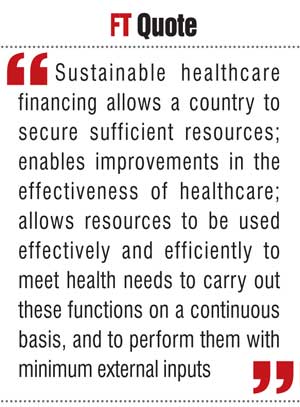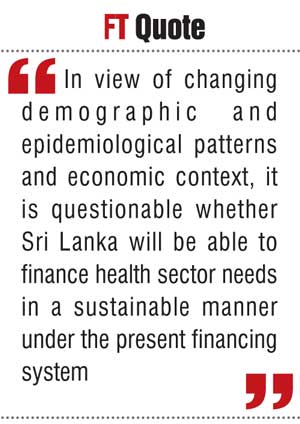Tuesday Mar 11, 2025
Tuesday Mar 11, 2025
Wednesday, 7 December 2016 00:01 - - {{hitsCtrl.values.hits}}
Health is a crucial input into economic development and poverty reduction. The levels and distribution of health outcomes can be regarded as a key indicator of the inclusiveness of a country’s economic growth; they also often serve as proxies for a government’s concern for all its citizens.
By and large, Sri Lanka’s health sector has contributed to the country’s economic development, recording progress in achieving health indicators and maintaining their status. The health status depicted by such indicators places Sri Lanka at a more advanced position than many of its developing country regional counterparts, and in par with developed countries. Sri Lanka’s considerable health sector achievements are financed through a combination of general taxation and out-of-pocket payments by households.
Models of healthcare financing
In general, healthcare financing refers to the ways in which money is generated to pay for health services. There is a wide variety of healthcare systems around the world. These can be categorised into four main models: the Beveridge model, the Bismarck model, the national health insurance model, and the out-of-pocket model.
There are different sources of funding these healthcare systems. Most typically, the five primary methods of funding are: (i) general taxation to the state, county or municipality; (ii) social health insurance (iii) voluntary or private health insurance (iv) out-of-pocket payments; and (v) donations to charities.
Sri Lanka’s healthcare system
Sri Lanka has a pluralistic system of care with many people utilising a combination of systems but by far, the dominant system is the Western system of care. The health system in Sri Lanka consists of public and private healthcare services, but the government plays the major role as the healthcare provider of the country.
While Sri Lanka has a free healthcare system based on the principle of citizenship, it does not meet the quality health needs of all people – a fundamental requirement of a universal healthcare system. Universal health coverage (UHC) is defined as all people receiving quality health services that meet their needs without being exposed to financial hardship in paying for the services.
 Healthcare financing in Sri Lanka
Healthcare financing in Sri Lanka
Sri Lanka’s healthcare financing strategy is essentially a combination of two resource mobilisation methods; (1) general taxation and (2) out-of-pocket payments by households.
Sri Lanka’s TEH as a percentage of GDP has hovered around 3-4% with a decline in more recent years. Whilst health expenditure is comparable with that of other lower middle income economies, the amount of money allocated for spending is not adequate in the context of changing disease patterns which is more similar to a high income economy.
Need for alternative financing mechanisms
Sri Lanka’s healthcare expenditure is likely to increase in the future owing to: (i) increased demand for more expensive treatments; with rising income levels along the transition to middle income status, there will be greater demand for more expensive treatments and higher service quality requiring more financial resources to be allocated; (ii) meeting health needs of an aging population; and (iii) the increase in non-communicable diseases (NCDs) related to an epidemiological transition.
Existing gaps in healthcare financing
The most critical gaps in Sri Lanka’s current system of healthcare financing are: (i) inadequacy of resource mobilisation; (ii) allocative inefficiency in the distribution of healthcare provision outcomes amongst the population; and (iii) weaknesses in financial management.
Towards a sustainable healthcare financing system and alternative mechanisms
Various innovative and alternative health financing methods ranging from market-based systems to government financed systems, from community funded to donor funded systems are to be found in practice. Of these alternatives, more focus is paid to four options –Private Public Partnerships (PPPs), Social Health Insurance (SHI), Community Based Health Insurance (CBHI), and User  Fees – to assess their possible benefits and potential to be adapting in Sri Lanka’s context. These mechanisms are some financial policy options available for Sri Lanka.
Fees – to assess their possible benefits and potential to be adapting in Sri Lanka’s context. These mechanisms are some financial policy options available for Sri Lanka.
Given the demographic and epidemiological transitions taking place in the country, and gaps in the existing healthcare financing mechanism, Sri Lanka has to look for alternative financial mechanisms. Experiences from other countries show that a combination of alternative financing options can result in positive outcomes while addressing market failures as well. The available options have to be analysed comprehensively considering the socio-economic context and the political economy of the country and have to be implemented with the aim of achieving Sri Lanka health objectives and ensure universal healthcare coverage.
[This Policy Insight is based on the comprehensive chapter on Healthcare Financing in Sri Lanka: Challenges and Alternatives in the ‘Sri Lanka: State of the Economy 2016 Report’. The State of the Economy Report is the flagship publication of the Institute of Policy Studies of Sri Lanka (IPS). The complete report can be purchased from the publications section of the IPS, located at 100/20, Independence Avenue, Colombo 7. For more information, contact the Publications Unit on 0112143107 / 0112143100 or e-mail [email protected].]
Discover Kapruka, the leading online shopping platform in Sri Lanka, where you can conveniently send Gifts and Flowers to your loved ones for any event including Valentine ’s Day. Explore a wide range of popular Shopping Categories on Kapruka, including Toys, Groceries, Electronics, Birthday Cakes, Fruits, Chocolates, Flower Bouquets, Clothing, Watches, Lingerie, Gift Sets and Jewellery. Also if you’re interested in selling with Kapruka, Partner Central by Kapruka is the best solution to start with. Moreover, through Kapruka Global Shop, you can also enjoy the convenience of purchasing products from renowned platforms like Amazon and eBay and have them delivered to Sri Lanka.
Discover Kapruka, the leading online shopping platform in Sri Lanka, where you can conveniently send Gifts and Flowers to your loved ones for any event including Valentine ’s Day. Explore a wide range of popular Shopping Categories on Kapruka, including Toys, Groceries, Electronics, Birthday Cakes, Fruits, Chocolates, Flower Bouquets, Clothing, Watches, Lingerie, Gift Sets and Jewellery. Also if you’re interested in selling with Kapruka, Partner Central by Kapruka is the best solution to start with. Moreover, through Kapruka Global Shop, you can also enjoy the convenience of purchasing products from renowned platforms like Amazon and eBay and have them delivered to Sri Lanka.